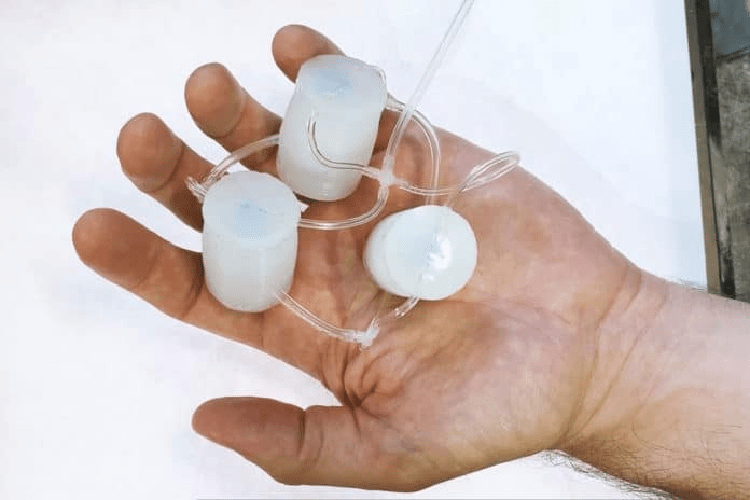Jul 9 2019
A well-known fact is that soft robots cannot invariably compete with the hard counterparts. Their rigid comrades fly, walk, and dive through volcanoes, dance to “Uptown Funk,” perform backflips, and dominate assembly lines.
 The first soft ring oscillator gets plushy robots to roll, undulate, sort, meter liquids, and swallow. (Image credit: Harvard University)
The first soft ring oscillator gets plushy robots to roll, undulate, sort, meter liquids, and swallow. (Image credit: Harvard University)
However, every year, new abilities are gained by soft robots. For instance, these objects have learned to grip, jump, and squirm. They can also handle tomatoes without damaging the fruit, travel through disaster zones, radiation, and outer space, and emerge unharmed after being run over by a vehicle, all without the complications facing their harder counterparts. For animals and people, soft robots have a “cooperative function”—a soft touch.
In the recent past, scientists in the laboratory of George M. Whitesides—the Woodford L. and Ann A. Flowers University Professor—have developed soft replacements for the last solid parts needed to construct a robot.
Instead of wires and electricity, pressurized air creates movement by expanding and contracting rubber inflatables, soft valves replaced for the hard ones, and soft digital logic duplicates the same kinds of abilities of an electronic computer.
Now, the latest innovations from postdoctoral scholar Daniel J. Preston give new, intricate movements to these robots. As the first author on a research featured in Science Robotics late last month, Preston launched the first-ever soft ring oscillator, which provides these robots the ability to sort, roll, undulate, swallow, and measure liquids.
It’s another tool in the toolkit to make these smart, soft robots without any electronics, and without any hard valves.
Daniel J. Preston, Study First Author and Postdoctoral Scholar, Harvard University
To date, ring oscillators were typically made with microfluidics or electronic transistors. Electronics invariably need hard components, and so do a majority of microfluidics. Glass is used by many of them for their pressurized air or water systems.
The macroscale pneumatic ring oscillator developed by Preston depends on air and inverters. It controls the air pressure in the rubber tubes of the robot—if the input is low pressure, the output will be high pressure, and vice versa. Connecting three or other odd numbers of gates in a ring causes one gate’s shift to activate the next, which, in turn, activates the next, and so on.
The cool response that you get when you combine an odd number of these inverters in a loop is an instability that travels around the loop.
Daniel J. Preston, Study First Author and Postdoctoral Scholar, Harvard University
Preston compares it to a Slinky that collapses to spring down a flight of stairs, producing a steady pace without the necessity for another push.
In order to find out what the soft ring oscillator could actually do, Preston, along with his team members, produced five prototypes. Each prototype utilizes one constant source of air pressure to run three pneumatic actuators, or the inverters.
While a ball is nudged around a ring by one prototype, another one undulates a stage to maintain beads of two varied sizes rolling against the edge. Ultimately, all the tinier beads fall via a hole in the stage’s side, and they sort themselves out.
“The ring oscillator is really good for things like rolling motions,” Preston added.
Rolling needs coordination of a number of actions in time. Just one input and output is not sufficient. For instance, in order to cause the hexagonal foam robot to roll forward, the ring soft oscillator helps in inflating a balloon behind the robot and also deflating another one in front at the same, precise time. This coordinated push-and-release process causes the hexagon to move forward repeatedly as the balloons deflate and inflate in perfect sync.
There is another prototype that offers a more concrete purpose. A textile-based sleeve, enclosed around the lower leg and fastened with Velcro, applies coordinated pressure, thereby “pumping” fluid up the leg. This motion of pumping enhances symptoms of chronic venous disease and lymphedema when compared to simple compression, according to new studies.
The novel device can also help police officers, nurses, and waiters prevent deep-vein thrombosis, an outcome of working extended shifts on tired feet.
Before clinical trials are initiated for the textile-based sleeve, the researchers want to gauge public’s interest. If a sufficient number of people are looking for a softer and less-costly means to reduce and prevent symptoms, the product could perhaps find a market that is large enough to qualify for additional studies.
Preston’s materials—that is, rubber-like silicone elastomers—are not expensive and hence they are suitable for more than just low-cost home care. Sterile, gentle, disposable, and biocompatible versions can be utilized for drug delivery, laboratory experiments, or even medical devices within the body similar to a sleeve that assists the heart beat developed by researchers at Harvard and Boston Children’s Hospital.
The final prototype developed by Preston has the potential to sort hree different colored liquids on the basis of a predetermined time and sequence—a tool that might be handy for chemists.
According to Preston, his innovation may lead to much more applications than the ones shown by him in his five prototypes. As the paper describes a way to duplicate and customize the design, Preston hopes that other laboratories will find even more applications for this.
People can use the soft ring oscillator for a lot of different applications in soft robotics, some of which we may not have even thought of or envisioned yet.
Daniel J. Preston, Study First Author and Postdoctoral Scholar, Harvard University
The study was funded by the Department of Energy (DOE) Office of Basic Energy Science, Division of Materials Science and Engineering (ER45852); National Science Foundation (IIS-11317744), NSF MRSEC (DMR-1420570); Harvard University Mobility Scheme; U.S. Department of Defense, National Defense Science and Engineering Graduate Fellowship Program; and National GEM Fellowship.
(Video credit: Vanessa Sanchez)